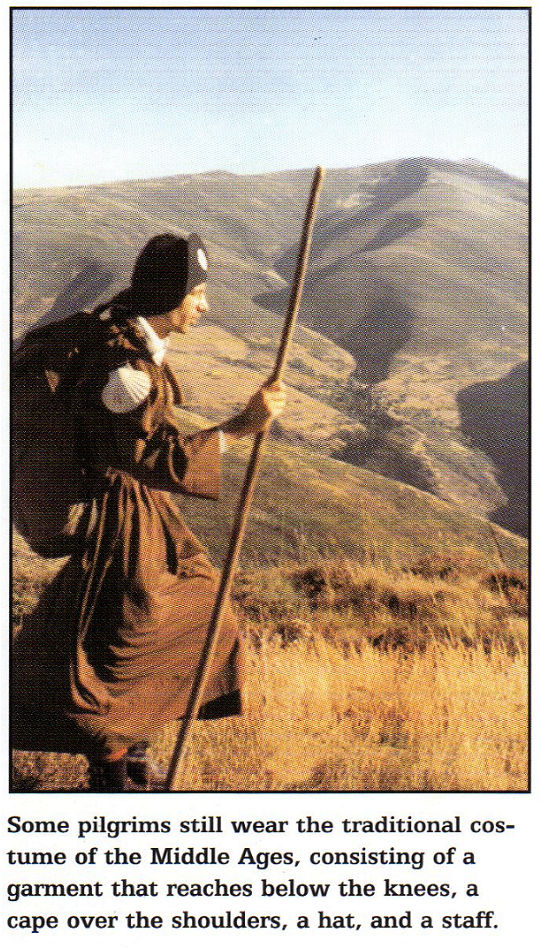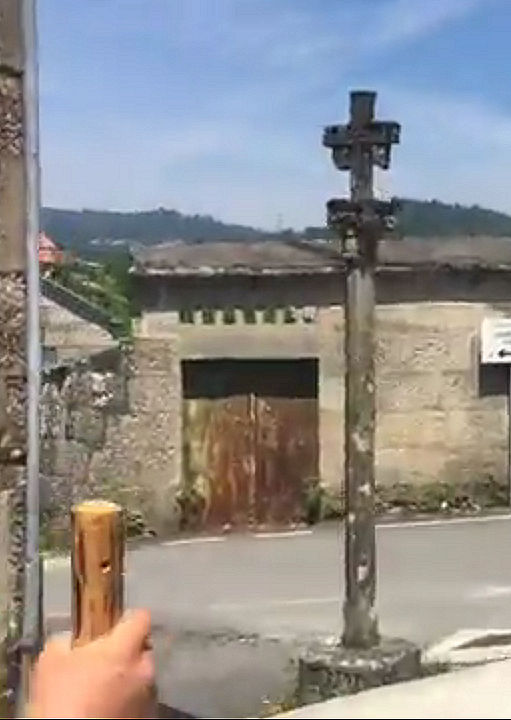By Julian Martins
 In the eleventh century, a poor, tired, and thirsty pilgrim crossed one of the most difficult mountain passes in Navarre, Spain. He was headed for the faraway lands of Galicia, to the shrine of Saint James the Greater, where the remains of this great saint had been miraculously discovered two centuries earlier. He still had 500 miles to go before reaching this holy place.
In the eleventh century, a poor, tired, and thirsty pilgrim crossed one of the most difficult mountain passes in Navarre, Spain. He was headed for the faraway lands of Galicia, to the shrine of Saint James the Greater, where the remains of this great saint had been miraculously discovered two centuries earlier. He still had 500 miles to go before reaching this holy place.
For now, he was walking through a region of historic battlefields where Christian soldiers under the command of Charlemagne had waged war against the Moslem invaders. Countless pilgrims had passed this way before him for the same reason. Our pilgrim began to wonder if all of them had had such a difficult time as he. It seemed that Providence was really testing his faith. Exhaustion was setting in after hundreds of miles of heat, dust, and thirst. The thought of another 500 miles in these conditions caused no small discouragement. Human nature has its limits, he thought, and a bit of water would be a great help at this moment. But there was none to be found. Legend has it that the devil, the great exploiter of human weakness, saw a good opportunity to approach our afflicted pilgrim. At one of the curves along the way, the devil appeared and offered to lead the pilgrim to a copious spring of crystalline water. The devil, of course, had his price. In exchange for the water, the pilgrim would have to hand over his soul. Our pilgrim valiantly resisted this temptation. In reward, Saint James himself appeared to him and opened a spring in the ground then and there to slake his faithful disciple’s thirst. To this very day, one can visit and drink from this same pure mountain spring in Navarre’s “Pass of Pardon.” One thousand years have filled the walk to Santiago de Compostela with abundant history. For my whole life I have dreamt of following the footsteps of the pilgrims. But before we get too far along, let us take a look at the walk’s origins.
After the death of Our Lord Jesus Christ, the Apostles began to traverse the known world to spread the Gospel. Saint James the Greater, assigned to Spain, labored there for two years, but without success. Around A.D. 40, Our Lady, then still alive, was carried by angels to visit Saint James in Zaragoza. The Holy Virgin encouraged the Apostle to continue his labors. As a gift, She left him a small image of Herself that angels had brought from Heaven. Soon afterward, Saint James returned to Jerusalem where he was beheaded by order of Herod and his body thrown to the animals. Under cover of darkness, his disciples retrieved his remains and, according to tradition, placed them aboard a boat at the port of Jaffa. They then sailed to “Finisterrae,” the end or furthest part of the known world. The great Apostle’s body was buried on a hill called Libredon about 18 miles from Spain’s Atlantic coast. The body lay undiscovered for some 800 years until a hermit named Pelayo dreamt that the Apostle’s body was soon to be discovered. Not long after, several shepherds saw a magnificent star illuminating part of a field. Digging there, they discovered Saint James’ body. Hence the name of the city that grew up there, Santiago de Compostela—Saint James of the field of the star. News of the discovery spread quickly throughout Christian Europe, and pilgrims of all nationalities came from far and wide to venerate Saint James and implore his favor. The discovery also served as a great incentive for Spain, then almost completely dominated by the Saracens, to free itself. Saint James, titled the “Moorslayer,” became the patron of the Spanish Reconquest.
 Having the providential opportunity to live in the marvelous city of Santiago de Compostela for a year, I heard most exciting stories from countless pilgrims arriving there after weeks of walking. The joy and satisfaction that shone in their faces after so much suffering particularly caught my attention, for the walk to Santiago is no small affair. The many stories, the need to do penance for my sins, and the fact that 1999 would be the century’s last “Holy Year of Compostela,” gave me the final push to strike out on this adventure. These Holy Years, when the Apostle’s feast day, July 25, falls on a Sunday, were established by Pope Calixtus II. In 1179, Pope Alexander II, with the bull Regis Aeterna, granted a plenary indulgence to pilgrims who visit the remains of Saint James during such a year. I didn’t want to miss out.
Having the providential opportunity to live in the marvelous city of Santiago de Compostela for a year, I heard most exciting stories from countless pilgrims arriving there after weeks of walking. The joy and satisfaction that shone in their faces after so much suffering particularly caught my attention, for the walk to Santiago is no small affair. The many stories, the need to do penance for my sins, and the fact that 1999 would be the century’s last “Holy Year of Compostela,” gave me the final push to strike out on this adventure. These Holy Years, when the Apostle’s feast day, July 25, falls on a Sunday, were established by Pope Calixtus II. In 1179, Pope Alexander II, with the bull Regis Aeterna, granted a plenary indulgence to pilgrims who visit the remains of Saint James during such a year. I didn’t want to miss out.
The equipment of the Medieval pilgrim consisted of the customary hat with the shell, a short coat that did not impede walking, a poncho for rain, and a large staff that, although a bit awkward, helped the pilgrim defend himself along the way. In many remote areas, one often comes across dogs and other animals that need to be kept at a distance. Saint-Jean-Pied-de-Port in southern France has long been a traditional point of convergence for the different paths of pilgrims from all across Europe before crossing the Pyrenees. Saint-Jean, a typical walled city of the early Middle Ages, is so linked with the walk that its main gate is named “Saint James” and the gate exiting the city is called “Spain.” The road entering Spain crosses several Northern provinces, from Navarre to La Corunha.

The start of the pilgrimage at Saint-Jean Pied-de-Port (Pyrénées-Atlantiques, France), with the Nive river between.
At the Hostel of Saint-Jean, an old French lady stamped my pilgrim book for the first time. This book attests that one is an authentic pilgrim and has to be stamped at each stopping place for admission to the pilgrim hostels. It is also needed when one reaches Santiago to receive the “Compostela,” the certificate of completion of the pilgrimage. March is a cold month in southern France, especially in the Pyrenees. My first day on the walk was no different. The lady at the hostel advised me that few travelers had passed by so far due to inclement weather. Snow can hide the trail and guideposts, but I decided that a little risk would make my start all the more interesting.
As soon as I crossed the bridge over the Nive river into Spain the ascent began and I saw the first road signs for the walk. The mountain views are breathtaking and only the strong wind breaks the silence. This impressive atmosphere calls to mind the seriousness of the pilgrimage and even of life itself. From the onset, the going was rough. With thirty pounds of meager possessions on my back and a strong, cold wind in my face, the slightest climb became an effort. After several hours, I felt lightheaded and sometimes had to concentrate closely to keep my balance. Just as I had been warned, the snow had covered all the signs, so great attention was needed to discern the right way and avoid getting lost. What a relief it was then to find along the path a simple stone cross with just four words inscribed at its base: “I am the Way!” Pilgrims make small wooden crosses to place at the foot of this stone cross. The walk was a constant reminder of the truth that suffering is the way God Himself established as the only way to achieve anything meritorious in this life. Countless scenes of Our Lord’s Passion and of the Mother of Sorrows etched in stones along the way keep this before the pilgrim’s mind.
Nearing Roncesvalles, the path becomes less arduous. It is quite touching to reflect that 200 years before, in the small forest surrounding the pilgrim there, Roland and the rest of Charlemagne’s rearguard had died at the hands of the Moors. Before leaving that beautiful place, I made it a point to visit Roland’s tomb. Many sites in that area are linked to Charlemagne; one often finds a fountain where he drank, a place where he camped, a spot where he prayed facing Santiago de Compostela.
Numerous small villages along the way are called villas de Francos, French towns. These were founded by French pilgrims passing through the region. Churches, monasteries, hospitals, and pilgrim hostels line the single, wide main street along which the pilgrims pass. It is very inspiring to see that the villagers still hold the pilgrims in high regard. They commonly stop pilgrims to ask them for prayers when they reach Santiago, and then bid them Godspeed. Christian charity can still be found when it is most needed.
 Among the pilgrims’ worst enemies are the blisters. One can sometimes have so many that just setting foot on the ground feels like an electric shock. Not far from Pamplona, every blister on my feet burst. I don’t need to describe the feeling. All I could do was sit on the ground in the rain. While I sat there, a car stopped. A man who had made the pilgrimage some years before was taking his family to a restaurant. He offered to help me. He tended to my feet while giving me advice on how to reach Santiago safe and sound. His family simply stared in horror at the state of my feet. When I arrived at the Queen’s Bridge, 15 miles past Pamplona, the worst of the walk had passed. Though the blisters were still raw, my body had adapted to the extraordinary exercise. Such was the number of pilgrims who passed through this particular place in the eleventh century that Queen Doña Mayor, wife of King Sancho III, built a bridge over the river to aid them on their journey. Today, more than 900 years later, pilgrims still use that same bridge. Until the last century, a beautiful statue of Our Lady graced the bridge. The statue was known as Our Lady of Puy, meaning “page,” because every now and again a page would come and clean the face of the statue. Today, this image is kept as a precious relic in one of the local churches.
Among the pilgrims’ worst enemies are the blisters. One can sometimes have so many that just setting foot on the ground feels like an electric shock. Not far from Pamplona, every blister on my feet burst. I don’t need to describe the feeling. All I could do was sit on the ground in the rain. While I sat there, a car stopped. A man who had made the pilgrimage some years before was taking his family to a restaurant. He offered to help me. He tended to my feet while giving me advice on how to reach Santiago safe and sound. His family simply stared in horror at the state of my feet. When I arrived at the Queen’s Bridge, 15 miles past Pamplona, the worst of the walk had passed. Though the blisters were still raw, my body had adapted to the extraordinary exercise. Such was the number of pilgrims who passed through this particular place in the eleventh century that Queen Doña Mayor, wife of King Sancho III, built a bridge over the river to aid them on their journey. Today, more than 900 years later, pilgrims still use that same bridge. Until the last century, a beautiful statue of Our Lady graced the bridge. The statue was known as Our Lady of Puy, meaning “page,” because every now and again a page would come and clean the face of the statue. Today, this image is kept as a precious relic in one of the local churches.
[to be continued]
Short Stories on Honor, Chivalry, and the World of Nobility—no. 580











